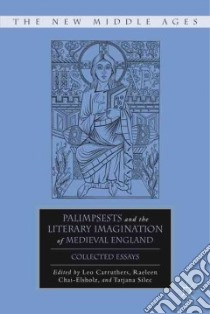Palimpsests and the Literary Imagination of Medieval England - 9780230100268
Un libro in lingua di Carruthers Leo (EDT) Chai-elsholz Raeleen (EDT) Silec Tatjana (EDT) edito da Palgrave Macmillan, 2011
- € 71.30
- Il prezzo è variabile in funzione del cambio della valuta d’origine
- Raeleen Chai- Elsholz, “Introduction: Palimpsests and ‘Palimpsestuous’ Reinscriptions”, pp. 1-17. - Adrian Papahagi, “An Anglo- Saxon Palimpsest from Fleury: Orléans, Bibliothèque Municipale MS 342 (290)”, pp. 21-33. - Peter A. Stokes, “Recovering Anglo- Saxon Erasures: Some Questions, Tools, and Techniques”, pp. 35-60. - Jane Roberts, “Some Psalter Glosses in Their Immediate Context”, pp. 61-79. - Paul E. Szarmach, “The Palimpsest and Old English Homiletic Composition”, pp. 81-94. - Sharon M. Rowley, “‘Ic Beda’” . . . ‘Cwæð Beda’: Reinscribing Bede in the Old English Historia Ecclesiastica Gentis Anglorum”, pp. 95-113. - Florence Bourgne, “Vernacular Engravings in Late Medieval England”, pp. 115-136. - Leo Carruthers, “Rewriting Genres: Beowulf as Epic Romance”, pp. 139-155. - Gila Aloni, “Palimpsestic Philomela: Reinscription in Chaucer’s “Legend of Philomela”, pp. 157-173. - Claire Vial, “The Middle English Breton Lays and the Mists of Origin”, pp. 175-191. - Colette Stévanovitch, “Enquiries into the Textual History of the Seventeenth- Century Sir Lambewell (London, British Library, Additional 27897)”, pp. 193-204. - Jean- Marc Elsholz, “Elucidations: Bringing to Light the Aesthetic Underwriting of the Matière de Bretagne in John Boorman’s Excalibur”, pp. 205-226.
Informazioni bibliografiche
- Titolo del Libro in lingua: Palimpsests and the Literary Imagination of Medieval England
- Sottotitolo: Collected Essays
- Lingua: English
- Autori : Carruthers Leo (EDT) Chai-elsholz Raeleen (EDT) Silec Tatjana (EDT)
- Editore: Palgrave Macmillan
- Collana: Palgrave Macmillan (Hardcover)
- Data di Pubblicazione: 15 Marzo '11
- Genere: Lingua Inglese
- Argomenti : English literature History and criticism English literature Old English, ca. 450-1100 Sources English literature Middle English, 1100-1500 Sources
- Pagine: 267
- ISBN-10: 0230100260
- EAN-13: 9780230100268



“These eleven original essays scrutinize the subject of the palimpsest, both literal and metaphorical, from a series of different angles and generate a rich and thought-provoking array of examples of different types of recycling and layering in verbal and visual texts from the Old English period to the present, from early medieval manuscripts to contemporary film. The range and depth of treatments of the palimpsest as both a concrete and a conceptual phenomenon are exemplary.” --Laura Kendrick, Professor of Medieval Studies, Université de Versailles “Altogether a fine tribute to, and celebration of, the life and work of a great scholar, André Crépin, on his eightieth birthday. ’Palimpsest’ is given a broad definition in this collection of essays to cover both the material and the literary, that is, any alteration, abridgement, or translation of earlier texts. The contributions range from a discussion of palimpsests in manuscripts such as Beowulf, on wax tablets and vernacular engravings in the late medieval period, and how new digital technology can enhance our knowledge of palimpsests, to a broader interpretation of the word to cover the retelling, adaptation, or translation of earlier works in particular in the romance tradition, culminating in modern film adaptation of medieval literary works.” --Graham Caie, Vice Principal, University of Glasgow “Covering palimpsests both literal and literary, and ranging in subject matter from Beowulf to John Boorman’s Excalibur via Bede, the matière de Bretagne, Chaucer, and more, the contributions to this volume honor André Crépin with a sparkling series of investigations into the materiality, the composition, and the transmission of Old and Middle English texts.” --Timothy Graham, Associate Professor, University of New Mexico
- Raeleen Chai- Elsholz, “Introduction: Palimpsests and ‘Palimpsestuous’ Reinscriptions”, pp. 1-17. - Adrian Papahagi, “An Anglo- Saxon Palimpsest from Fleury: Orléans, Bibliothèque Municipale MS 342 (290)”, pp. 21-33. - Peter A. Stokes, “Recovering Anglo- Saxon Erasures: Some Questions, Tools, and Techniques”, pp. 35-60. - Jane Roberts, “Some Psalter Glosses in Their Immediate Context”, pp. 61-79. - Paul E. Szarmach, “The Palimpsest and Old English Homiletic Composition”, pp. 81-94. - Sharon M. Rowley, “‘Ic Beda’” . . . ‘Cwæð Beda’: Reinscribing Bede in the Old English Historia Ecclesiastica Gentis Anglorum”, pp. 95-113. - Florence Bourgne, “Vernacular Engravings in Late Medieval England”, pp. 115-136. - Leo Carruthers, “Rewriting Genres: Beowulf as Epic Romance”, pp. 139-155. - Gila Aloni, “Palimpsestic Philomela: Reinscription in Chaucer’s “Legend of Philomela”, pp. 157-173. - Claire Vial, “The Middle English Breton Lays and the Mists of Origin”, pp. 175-191. - Colette Stévanovitch, “Enquiries into the Textual History of the Seventeenth- Century Sir Lambewell (London, British Library, Additional 27897)”, pp. 193-204. - Jean- Marc Elsholz, “Elucidations: Bringing to Light the Aesthetic Underwriting of the Matière de Bretagne in John Boorman’s Excalibur”, pp. 205-226.